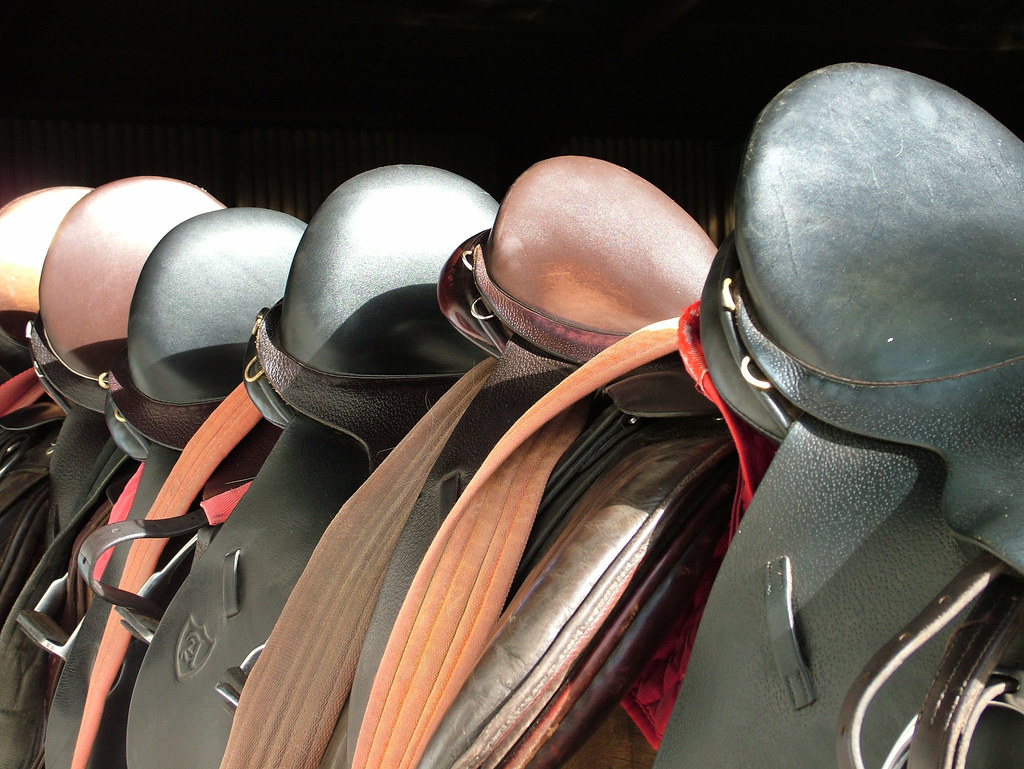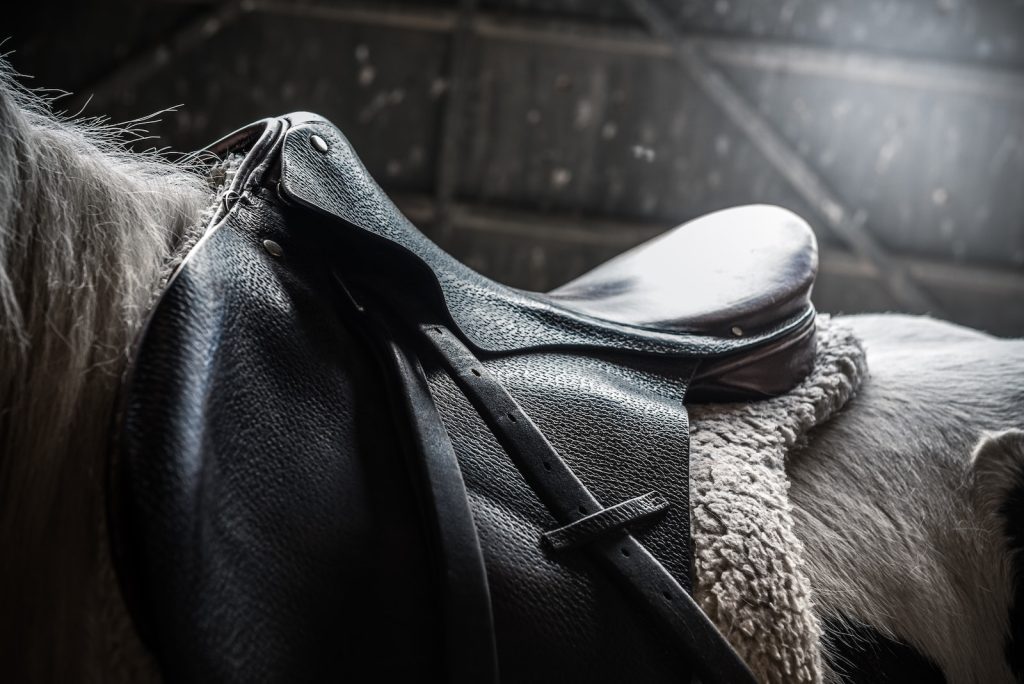Types of English Saddles
Traditional All-Purpose English Saddles
Traditional all-purpose English Saddles are versatile companions suitable for riders engaged in a diverse range of activities. They offer a balanced seat, making them a popular choice for riders of all levels.
Dressage Saddles
Dressage saddles exude precision and elegance. With deep seats and elongated, straight flaps, these saddles promote proper rider positioning and seamless communication with the horse.
Jumping Saddles
Jumping saddles prioritize close contact and shorter stirrup lengths, enabling riders to navigate obstacles while maintaining stability and security.
Close Contact Saddles
Close contact saddles are tailored for show jumping and equitation. They boast minimal padding and a streamlined design, fostering an intimate connection between rider and horse.
Eventing Saddles
Eventing saddles blend elements of both dressage and jumping saddles. They offer balance and security for cross-country riding while facilitating freedom of movement.
Anatomy of a English Saddles
Pommel and Cantle
The pommel at the saddle’s front and the cantle at the back provide essential support and structure. They help riders maintain a centered position during various riding activities.
Seat and Panels
The seat is the rider’s place of rest, while the panels underneath distribute the rider’s weight evenly across the horse’s back. Well-padded panels ensure comfort for both horse and rider.
Flaps and Billets
Flaps cover the panels and offer support to the rider’s legs. Billets, on the other hand, secure the girth, ensuring the saddle stays in place. Different English Saddles types feature varying flap lengths and positions.
Stirrup Bars and Girth Straps
Stirrup bars serve as attachment points for the stirrup leathers, promoting rider balance. Meanwhile, girth straps ensure the girth’s secure placement, preventing saddle slippage.
Selecting Ideal English Saddles
When embarking on the journey of choosing an English saddle, several factors warrant consideration:
Consider Riding Discipline
Different saddles align with distinct disciplines. Opt for a saddle that complements your riding aspirations, whether they involve dressage, jumping, or versatile riding.
Finding the Perfect Fit
Saddle fit is a paramount concern for both rider and horse comfort. Collaborate with a proficient saddle fitter to ensure the saddle’s dimensions suit your horse’s conformation.
Material and Construction
English saddles come in a range of materials, encompassing leather and synthetic alternatives. The saddle’s construction significantly influences its longevity, comfort, and overall performance.
Budget and Brand
Establish a budget range and explore reputable brands renowned for crafting high-quality saddles within your designated financial scope. Delve into customer reviews and seek recommendations from experienced riders.
Proper Care for Your English Saddles
Owning an English saddle entails a commitment to its proper upkeep. Regular maintenance not only prolongs the saddle’s lifespan but also contributes to an optimal riding experience.
Cleaning and Maintenance
Frequent cleaning with a mild saddle soap and a damp cloth is advised to eliminate dirt and sweat accumulation. Conditioning the leather prevents it from drying out and developing cracks.
Storage Guidelines
Store your English Saddle in a cool, dry location away from direct sunlight and extreme temperatures. Employ a saddle cover to safeguard it from dust and moisture.
Regular Inspection
Routine examinations of your saddle are crucial. Monitor stitching, leather condition, and billets on a consistent basis. Address minor issues promptly to avert potential escalation.
Achieving the Perfect Saddle Fit
Attaining a well-fitted saddle is pivotal for successful riding experiences. A suitable fit not only enhances comfort but also contributes to overall rider and horse performance.
Recognizing Fit Importance
An ill-fitting saddle can lead to discomfort, limited movement, and even long-term physical problems for the horse. Riders may also grapple with balance and posture issues.
Professional Guidance
Enlist the expertise of a skilled saddle fitter to assess your horse’s conformation. Their insights aid in selecting a saddle that benefits both horse and rider.
Indicators of Poor Fit
Remain attentive to signals of an inadequately fitting saddle, such as uneven sweat patterns, appearance of white hairs, behavioral shifts in the horse, and resistance during tacking and riding.
Benefits of a Well-Fitted Saddle
Riding with a properly fitting English saddle is accompanied by numerous advantages that foster an effective partnership between rider and horse.
Enhanced Rider Comfort
An appropriately fitting saddle bestows a comfortable seat upon the rider, mitigating the risk of discomfort and strain during prolonged rides.
Optimized Horse Performance
A contented horse can move freely and activate its muscles effectively, resulting in improved performance across diverse riding activities.
Injury Prevention
A well-fitted saddle reduces the likelihood of soreness, pressure points, and muscular imbalances that could potentially lead to injuries over time.
Saddle Accessories and Pads
Supplementary accessories and pads contribute to enhanced comfort, support, and the overall riding experience.
Saddle Pads
Saddle pads offer an additional layer of cushioning and safeguard the horse’s back from friction. Opt for a pad that aligns with your riding discipline and saddle type.
Stirrup Leathers and Irons
Ensure the stirrup leathers are appropriately adjusted in terms of length. Comfortable stirrups boasting adequate grip can enhance rider stability.
Girths
Select a girth that fits snugly without inducing discomfort or chafing. The girth plays a pivotal role in keeping the saddle securely in place.
Breaking in a Fresh Saddle
Introducing a new saddle necessitates a gradual adaptation process to ensure both rider and horse become accustomed to the equipment for optimal comfort and performance.
Significance of Breaking In
New English Saddles often possess a stiff and unfamiliar quality. Gradually introducing the saddle to the horse’s routine minimizes discomfort and soreness.
Gradual Usage and Conditioning
Commence with shorter rides, progressively increasing saddle exposure. This aids in the softening of the leather and its adaptation to the unique contours of the rider and horse.
Conclusion
Mastering the intricacies of English saddles involves comprehending their diverse types, anatomy, fitting procedures, maintenance rituals, and advantages. A well-fitted saddle contributes to not only the longevity of the equipment but also the mutual satisfaction of both rider and horse. Prioritize proper saddle fit and care to foster a fruitful equestrian partnership.
FAQs
- How frequently should I clean my English saddle?
Regular cleaning, preferably after each ride, is recommended. More thorough cleaning can be performed weekly. - Is it acceptable to use a dressage saddle for jumping?
While feasible, utilizing a jumping saddle is advisable due to its design, which emphasizes balance and security during jumping activities. - What are indicators of an ill-fitting saddle?
Be vigilant for signs like white hairs, uneven sweat patterns, shifts in horse behavior, and resistance during tacking and riding. - Do synthetic saddles necessitate distinct care practices?
Yes, synthetic saddles might require specific cleaning instructions as provided by the manufacturer. Adhere to these guidelines. - How can I determine if my saddle requires re-flocking?
If the panels appear uneven or compressed, or if the saddle sits unevenly on the horse, it may be time for re-flocking.


